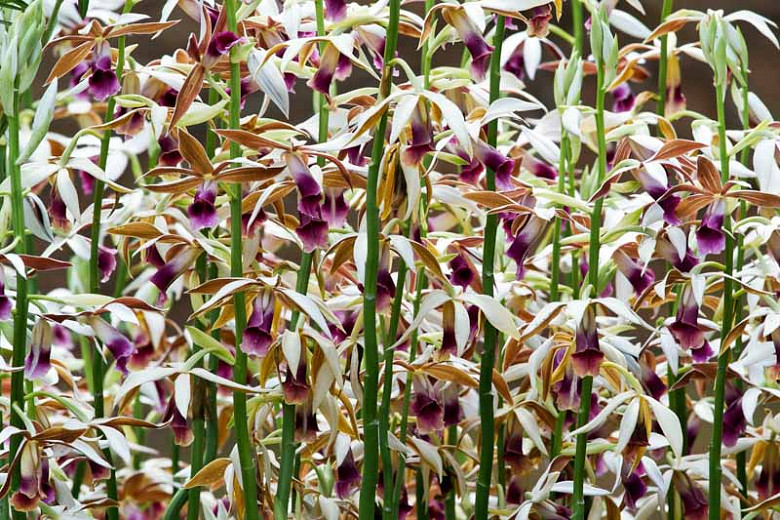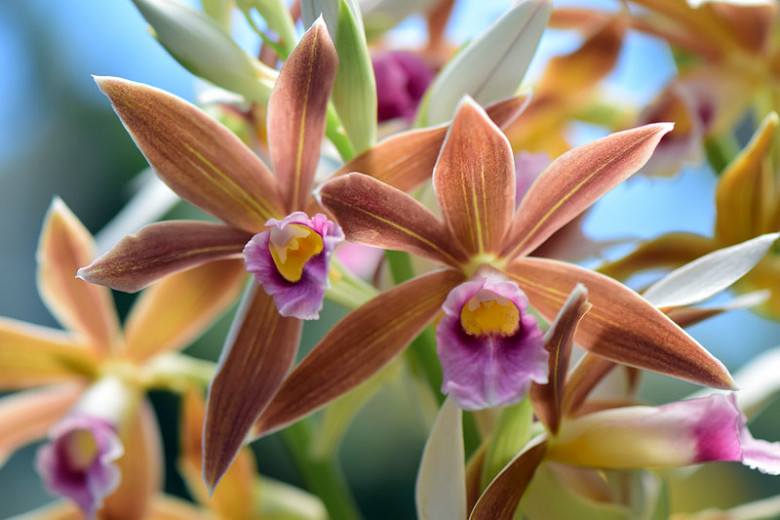Phaius tankervilleae (Nuns Orchid)
Phaius tankervilleae (Nun's Orchid) is a fairly large, terrestrial orchid species boasting multiple flower spikes densely packed with up to 10-20 fragrant flowers. Blooming in late winter to early spring, the showy hooded blossoms, 5 in. across (12 cm), are rusty brown with a purplish lip. Each inflorescence opens over a period of up to six weeks, and the flowers last for about a month. Nun's Orchid produces ovoid or conical, green pseudobulbs bearing a few large, thin-texture, pleated leaves which can reach about 3 ft. (90 cm). Native to Subtropical and Tropical Asia, Nun's Orchid is a hot to cool growing orchid species found in grassland and open forest at elevations of 1100-5300 ft. (350-1600 m). Adaptable and easy to maintain, this attractive orchid is considered easier to care for than most other orchid varieties. In frost-free areas, this orchid can also be grown outdoors.
- Grows up to 36-48 in. tall (90-120 cm).
- Easily grown in a well-drained but humus-rich compost in bright light to light shade, but not direct sun. Provide supreme air circulation year-round to prevent Botrytis fungus.
- Requires hot to cool temperatures between 60-70°F (15-21°C).
- Maintain adequate humidity (50%) for most of the year by standing your container in a tray of damp pebbles.
- Keep your Phaius orchid evenly moist, allowing slight drying between waterings.
- Feed with a water-soluble 20-20-20 fertilizer diluted to half-strength once a month, or apply a slow-release 20-20-20 fertilizer once every three months.
- Propagation: after flowering, split clumps of pseudobulbs from established plants (leaving the roots attached) or root the expended inflorescence (lay it in a tray filled with damp sand. Maintain a moist environment with reduced light for two to three months).
- Once the flowers have faded, remove the spent flower spikes.
- Repot after flowering, splitting growth into four pseudobulbs per pot.
- Generally disease free. Keep an eye out for aphids, glasshouse red spider mites, mealybugs, and root rot (excess moisture).
- Native to China, Hong Kong, Taiwan, the Pacific Islands, Malaysia, and Indonesia.
- This species has become an invasive species in some countries such as Jamaica and Hawaii.
Requirements
| Hardiness | 9 – 11 |
|---|---|
| Plant Type | Orchids |
| Plant Family | Phaius – Orchids |
| Exposure | Partial Sun |
| Season of Interest | Spring (Early)Winter |
| Height | 3' – 4' (90cm – 120cm) |
| Water Needs | Average |
| Maintenance | Average |
| Soil Drainage | Well-Drained |
| Characteristics | Fragrant, Showy |
| Garden Uses | Beds and Borders, Patio and Containers |

